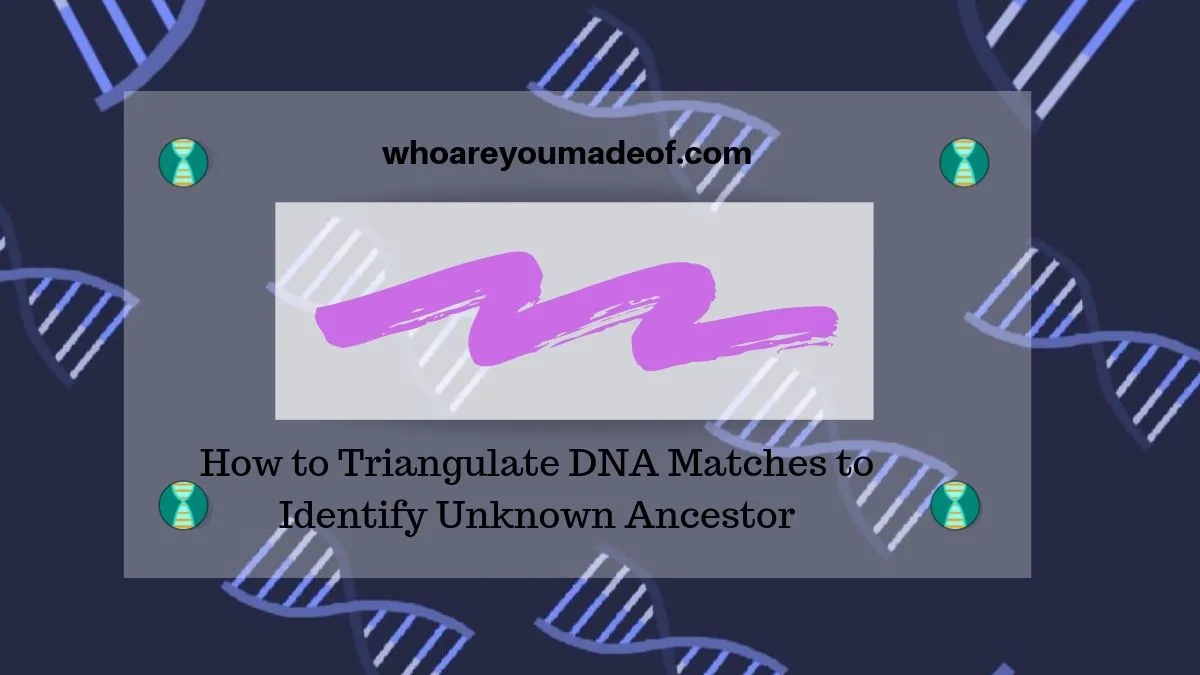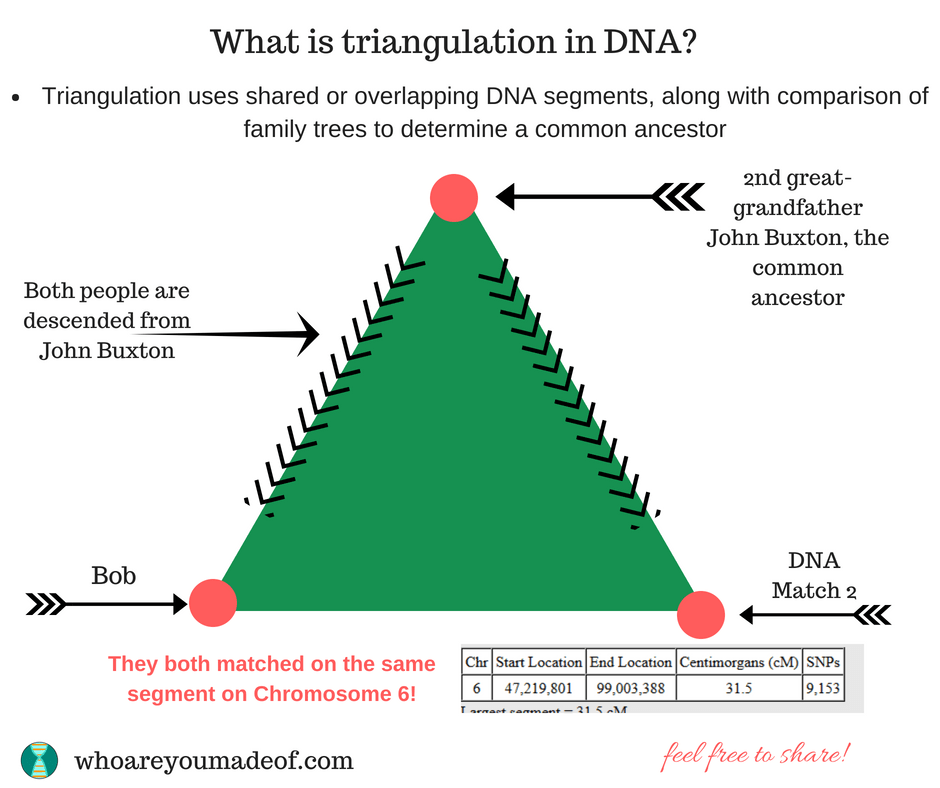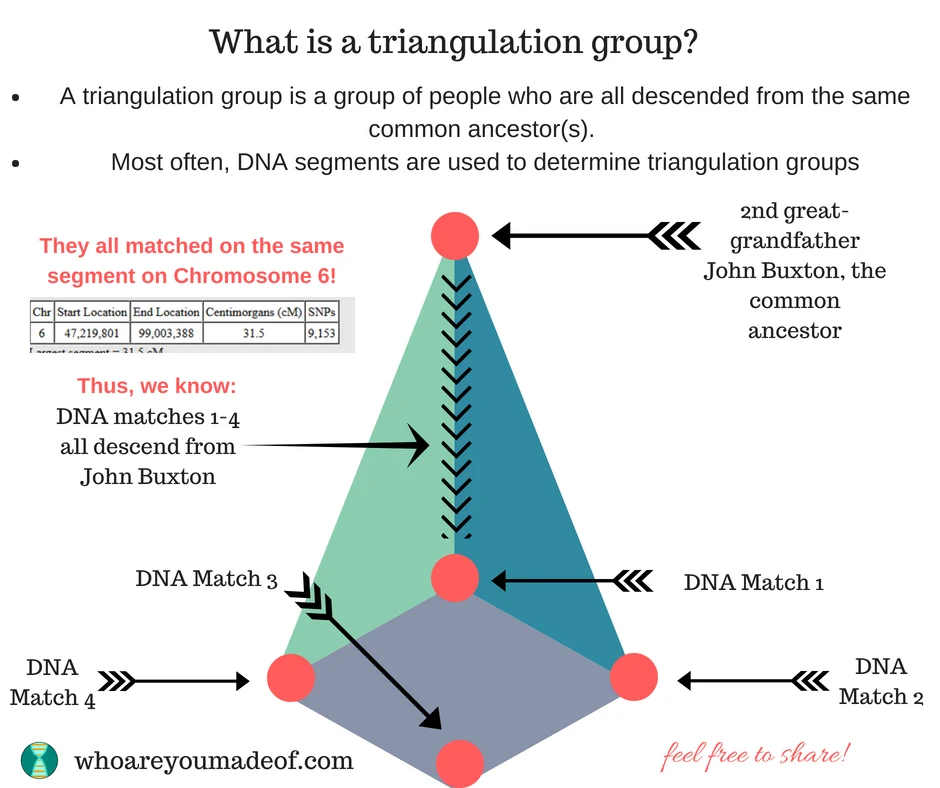Do you want to know how to triangulate DNA matches to identify an unknown ancestor? In this post, I will teach you a few techniques that you can use with multiple DNA matches to learn more about a particular line of your family tree.
I've been working on my mother's family tree for years now, and there are a few lines of her tree that seem to give me an extra amount of trouble.

Take, for example, my great-great-great grandfather Dougherty. He was born in Ireland in 1844, and that is just about all that I know about his origins.
I have been able to research his life in the United States, but anything that happened before his arrival here is a mystery to me.
Now that I have decided to get serious about using triangulation to determine who Dougherty's ancestors were and where they came from, I decided to write up a post about using triangulation techniques for this purpose.
I hope that it helps you learn some new strategies for using triangulation to learn more about your family tree.
Two types of triangulation to use with DNA matches
The genetic genealogist "purists" out there will be glad if I point out that there are two distinct "triangulation" techniques that you can use with your DNA matches in order to identify mystery ancestors and learn more about your family's ancestry.
There is *true* triangulation, and triangulation "lite", as I like to call it.
True triangulation of DNA matches requires you to identify DNA segments that you and other DNA matches share in common and hypothetically inherited from the same common ancestor. Once the DNA segments have been identified, you can then research the family trees of the group of matches to identify shared lines, and hopefully, your mystery ancestor.
The image below is a visualization of true triangulation:

Triangulation "lite", on the other hand, uses only family tree information shared between a group of matches in order to identify common ancestors. This technique is most commonly used when detailed segment information is unavailable, or not provided on the DNA testing website.
While true triangulation is more scientific and leaves less room for error, I am of the opinion that any technique that helps us solve our family tree mysteries is a good technique.
Since I really, really, really want to learn more about my Dougherty ancestors, I am going to employ both methods.
How to know which DNA matches to use for triangulation
When choosing DNA matches to work with for triangulation, we have a few choices. We can choose matches that have great family trees that make our work easier, known relatives, or matches that we only have theories about.
The best DNA matches for triangulation have great family trees
Since this post is about how to use triangulation to discover your mystery ancestors and break through brick walls, I will stress that it's a good idea to find your "best" matches to work with. You will need as much information as possible.
Our best choices for triangulation will be DNA matches with whom we have already determined our connection (maybe they are known relatives). A second-best match will be a DNA match with an extensive tree that only needs us to go a generation or two back to find a link.
Read about how to find your connection with a match by building a tree here:
What if you don't have any "good" DNA matches to choose from for triangulation
If you are trying to learn about a "mystery" ancestor, you might have to be creative in choosing the DNA matches to use for triangulation. For example, one of the DNA matches that I will use for triangulation is someone who I only think is descended from my Dougherty ancestor.
She matches my mom on 23andMe and has listed Dougherty on her list of surnames in her tree. Since she is probably related to my mom at a 3rd cousin relationship or closer, and the other surnames on her list aren't familiar to me, I'm betting on this match revealing something new.
Just to make sure that I am on the right track with this DNA match that I'll use for triangulation, I entered her into my mom's profile on DNA Painter. DNA Painter is a helpful site for chromosome mapping, and it can help you keep track of your DNA segments, DNA matches that match on certain segments, and even help you figure out how you may be related to your match.
When I painted her into my mom's DNA Painter profile, I noticed that she matches my mom on a 32 cM segment on the X chromosome. Since I know for sure that this is a paternal match for my mom and I understand about X DNA matches, I can be sure that this match is on my great-grandmother's line, and it just might lead me to my Dougherty ancestors.
My point in explaining all of this to you in this section is to help you understand how every clue can help us figure out which matches to work with.
How to tell how your DNA match is related when they don't have a family tree?
If you have found a DNA match that seems like they might be related on the line that you would like to triangulate, but they don't have a family tree or don't know much about their ancestry, don't worry!
With a little bit of work, you might be able to find out for sure which line of your family they are on to make sure they are a good match to use for triangulating your mystery ancestor.
For example, I mentioned a DNA match above that had "Dougherty" listed among the two surnames on her 23andMe profile. I'm out of luck, right?
I was able to do a quick Google search including her name and two names she listed on her profile. Lo and behold, I found a family tree online that had an entry for who I thought might be her mother.
Since I now had the names of both of her parents, I was able to use traditional family tree building techniques to build a "quick and dirty" tree to see if any of her parents' lines took me to a "Dougherty" relative.
Sure enough, her grandmother was born Dougherty. In only about 5-10 minutes, I was able to learn that her grandmother's grandfather was the same Dougherty that I am researching.
I have written a post with a complete list of ideas for how to figure out how a DNA match is related to you. If you are trying to identify a mystery ancestor, you will want to be sure that your DNA matches are really related to you on the correct line of your tree:
Choose the other DNA matches you will use to complete your triangle
As you saw in the image towards the beginning of this post, triangulation needs at least three points. I have already chosen the first point for my triangle, and now I need to choose another DNA match to make up the other point for the bottom of the triangle.
In theory, I could choose my mother. Because I'm trying to identify the ancestors of my Dougherty ancestor, and I already know how my mom is descended from him, I don't think she is a good choice for the other point.
I want to learn something new!
In order to find out who Dougherty's ancestors are, I need to find other DNA matches who are descended from Dougherty's ancestors. My first DNA match helped me identify the DNA segments that my mother likely inherited from her Dougherty ancestor.
Ideally, I will be able to find other DNA matches who share the same DNA segments with my mother. Hopefully, some of these DNA matches will be descended from ancestors further back in the Dougherty line.
Suggestions for finding matches to complete a triangulation triangle
To find other DNA matches to triangulate with my mom's 23andMe match, I will:
- examine shared matches on 23andMe to see if I can determine if we are all related on the Dougherty line
- check to see if my mom's 23andMe match has tested with any of the other DNA testing companies to look for shared matches on those sites
- use the matching segment search on Gedmatch, and try to find family tree information for those Gedmatch matches (see: How is my Gedmatch match related to me?)
If I get lucky, I might find several DNA matches - enough to build a triangulation group.

Shared matches for triangulation - use with caution
Since we don't have detailed segment data for all of our DNA matches, many times we must depend on shared matches in order to use triangulation techniques. This is generally acceptable, but there is one important thing that you should know:
Just because you have shared matches with a DNA match does not mean that you are all descended from the same common ancestor.
For example, let's take a hypothetical Sally Smith as an example. Her dad's family is from the UK and her mom's family is from Eastern Europe.
If Sally shows up as a DNA match to me, one of the first things that I might do is check to see who our shared matches are. I need to be aware that these DNA matches might be related to me and Sally in different ways.
Let's imagine that Sally and I share John Warsaw and Susan London as matches in common. It is possible that John, Susan, and Sally are all related to me via the same common ancestor.
However, it is also possible that Susan London and Sally are related to me on my great-grandmother's Smith line, and John Warsaw is connected to me through my great-grandmother's Polish line.
This would mean that John Warsaw and Susan London are not related to each other, but are both related to me and Sally.
Knowing that this is a possibility will help you spot occasions when this is the case and will save you time and frustration. Looking for connections that aren't there is very time consuming.
Identify the common ancestor with triangulation
Once you have figured out which DNA matches to use for your triangulation efforts, you will need to build out all of their family trees in order to discover where they intersect.
This may seem tedious, but for those of us who have spent years searching through genealogy records in vain, the effort is worth it!
Verify triangulation results with genealogy
Once you have identified an ancestor that your triangulation group (or triangle) shares in common, you will probably need to research that particular person or family in order to find how your mystery ancestor is descended from them.
For example, once I am done triangulating all of my mom's Dougherty matches, I may discover a person (or couple) from whom I suspect my Dougherty great-great-great grandfather is descended. I will then need to research all of the descendants of my suspected ancestor in order to find my Dougherty link.
Once I have completed this task, which will take longer than it did for me to write this post, I will then have to verify my work through typical genealogy records.
This means that once I believe I have identified the parents of my Dougherty ancestor, I will need to find records and documents, and maybe additional DNA matches, to back up my theory.
Conclusion
I hope that this post has helped you learn about how to use your DNA matches for triangulation, both with and without segment data. It is the best way to use all of the information available from your matches to learn as much as you can about your family tree.
If you have any questions about something that you tread in this post, or if you would like to share your own experience using triangulation to learn about your ancestors, I would love to hear from you in the discussion below.
Thanks for stopping by today!

